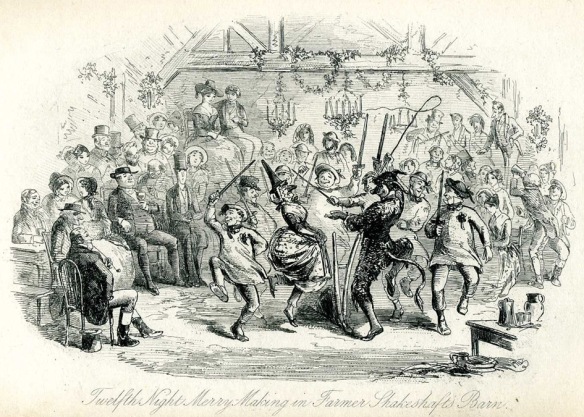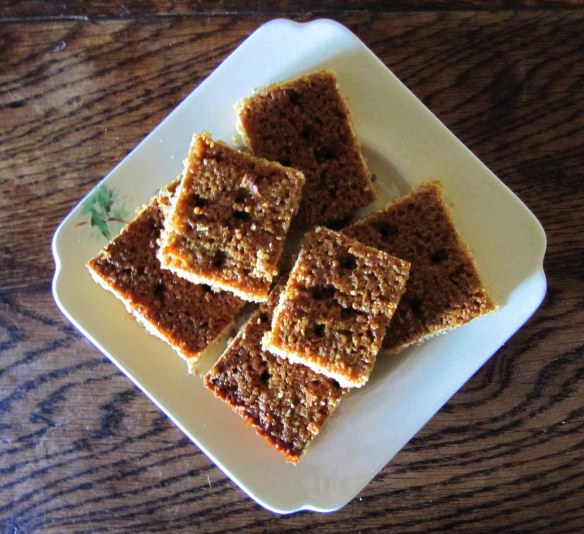This is a Christmas recipe, but I make no apology for posting it today. Today is 6 January, or Twelfth Night so a) Christmas isn’t over yet, b) as it’s Twelfth Night I shall turn the world upside down and do as I please. The doing as I please part will include making a tenuous claim that baking these deeply delicious, nutty, fruity, gingery, chocolatey, and – yes – sugary biscuits could help you lose weight. So there.
You have almost certainly had Lebkuchen of one sort or another. The term encompasses a wide variety of gingery German Christmas biscuits. The Elisen Lebkuche is the Queen of Lebkuchen. Her capital is at Nürnberg (also spelt Nuremberg), so they are also known as Nürnberger Lebkuchen.
While the good people of northern Europe have been baking spicy, gingery biscuits to celebrate the good times since they finally got the trade routes sorted in the middle ages, this particular variety of Lebkuchen was first sold in the early 1800s. I have seen many claims on the Internet that Elisen Lebkuchen were named after a gingerbread maker’s beautiful daughter Elise and not one shred of substantiation but it’s a nice story, so let’s go along with it.
The distinguishing feature of these biscuits is they contain no flour, a lot of nuts, and generous quantities of mixed peel and my personal favourite, crystallised ginger. They are simultaneously chewy and melt-in-the-mouth gorgeous. They are so good and keep so well that I would like you to very seriously consider doubling the quantities below.
The ‘real’ biscuits from Nürnberg come in beautiful tins and boxes and have the magnificent gravitas that only a food that’s been made by a guild of incredibly serious bakers for hundreds of years can carry off. This recipe doesn’t offer you that kind of authenticity but it does present you with the opportunity to eat Lebkuchen any time of year. If you wanted to make them less Christmassy you could use more crystallized ginger and less mixed peel.

If you Google ‘nuremberg 1561’ you will find a number of websites claiming that this news sheet records a flight of UFOs passing over Nurnberg. Those aren’t UFOs you crazy people – they’re quite obviously Lebkuchen.
So here’s the diet part: After you’ve made the mixture you have to wait 24 hours to bake these little beauties. And after that you can’t eat them straightaway. In fact you have to wait another TEN DAYS. I hereby challenge you to go the whole eleven days without eating anything sugary. With Elisen Lebkuchen to look forward to at the end that should be easy. Says the Lady of Biscuit Misrule.
Elisen Lebkuchen (makes 30ish)
250g caster sugar
3 large eggs
½ teaspoon vanilla essence
100g chopped hazelnuts
160g ground almonds (ideally ground at home in the blender, so they are gritty rather than powdery)
25g walnuts, roughly chopped
1 tbsp. crystallised ginger, finely chopped (if you are a ginger fiend like me leave some lumps)
100g mixed peel, finely chopped (or whizzed but not pulverised in the blender)
½ tsp. cinnamon
⅓ tsp. each of ground cloves, coriander, allspice, nutmeg and cardamom
finely grated zest of ½ lemon and ½ orange
rice paper cut into 8cm circles (you will need about 30 – make 20 at first then see how many more you need)
1 apple
200g dark chocolate
Beat the eggs, sugar and vanilla essence until the eggs are foaming and all the sugar has completely dissolved. Then stir in the nuts, ginger, spices, mixed peel and grated orange and lemon zest.
Stir for just long enough to combine the ingredients. The mixture will look runny. That’s fine. You’ll see.
Cover the bowl and leave it in the fridge for 24 hours.
Next day preheat the oven to 200 C. Arrange some of your rice paper circles on a baking tray. You need to leave at least 2 cm between circles, so you won’t get many on a tray.
After a day in the fridge the biscuit mix should be nice and firm – more like dough. Take a large pinch and roll it into a ball. It should be about 7 cm in diameter – so when you set it on a piece of rice paper there’s half a centimetre of paper left showing all the way round.
When you’ve filled a tray pop it in the oven. Leave the Lebkuchen in for 12-15 minutes until they are light brown. It’s very important not to overdo them – the middle needs to stay soft and sticky. Transfer to a wire rack to cool and load up another tray. Repeat till all your mix is used up.
When the biscuits are room temperature take a large piece of greaseproof paper and line an airtight box or tin. Put the biscuits in and tuck the paper over so they’re loosely wrapped.
Now – weird but true – lay the peel of an apple on the paper. This helps keep the biscuits moist and will eventually make them smell like a very beautiful medieval orchard.
Seal up the tin, put the tin in the cupboard, close the cupboard and forget they are there for ten whole days.
Almost there.
To finish them off gently melt the chocolate and use it to coat the biscuits. Wait a bit longer for the chocolate to set.
And then devour.













